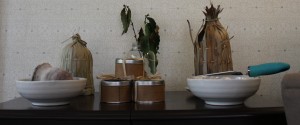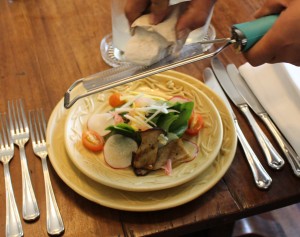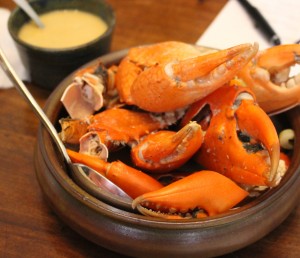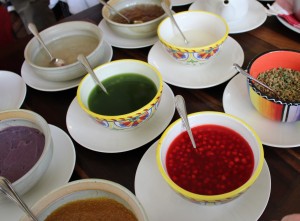 I first came across Amy Besa in her beautiful coffee table cook book, Memories of Philippine Kitchens. A chance meeting at Enderun, a few emails, and I finally introduced myself properly at a Christmas Fair in New York, where she and her husband Chef Romy Dorotan were showcasing a selection of interesting dishes from their Brooklyn based Filipino restaurant ‘Purple Yam’.
I first came across Amy Besa in her beautiful coffee table cook book, Memories of Philippine Kitchens. A chance meeting at Enderun, a few emails, and I finally introduced myself properly at a Christmas Fair in New York, where she and her husband Chef Romy Dorotan were showcasing a selection of interesting dishes from their Brooklyn based Filipino restaurant ‘Purple Yam’.
Last weekend we drove down to Manila Bay to see her latest venture, the Malate-based version of Purple Yam. Located in the original Besa family home at 603 Julio Nakpil, down a mind-boggling maze of back streets, it was almost the only house left in a street full of little supermarkets and sari sari stores. “We never abandoned the house,” Amy stated, as we assembled in the snug, upstairs dining room, once her mother’s bedroom. Built in 1949 by architect and artist Enrique Ruiz, it has been beautifully renovated and restored by Lara Fernandez-Barrios and the kitchen expanded into Amy’s own childhood bedroom. The original floor boards were subsequently recycled into attractive side tables.
We had arrived in time for a late brunch. The long dining table – a solid slab of wood (Molave) from Bacolod, Negros Occidental where Amy bought it twenty years ago as an antique piece – had been set for six under a stunning capiz chandelier. The menu, freshly printed, lay on the table to be studied at leisure, later. Meanwhile we heard much about Amy’s family history, the furniture, portraits and paintings that fill the house. Her baptismal godfather and National Artist of the Philippines, had long ago presented the family with a series of paintings, some of which still remain, and take pride of place in the dining rooms.
After a subtle hint from my hungry son, we brought an end to Amy’s fascinating stories and headed in to eat. It felt like an intimate family lunch, as we arranged ourselves in our private dining room. The only other customers – a table of four – were seated next door.
 Our waiters had already handed out glasses of refreshing homemade ginger beer as we sat down to a fresh, colourful palette of spinach salad, chaperoned by a variety of fruits and two wafer-thin slices of king oyster mushrooms, grilled and smoky and oh-so-delicious that I was tempted to ask for more please, like Oliver Twist. The salad was finished off with a light, bright pomegranate dressing. The waiter passed behind us with a solid chunk of salt from Amy’s ancestral land in Botolan, Zambales, to be grated over the top of our food like parmesan.
Our waiters had already handed out glasses of refreshing homemade ginger beer as we sat down to a fresh, colourful palette of spinach salad, chaperoned by a variety of fruits and two wafer-thin slices of king oyster mushrooms, grilled and smoky and oh-so-delicious that I was tempted to ask for more please, like Oliver Twist. The salad was finished off with a light, bright pomegranate dressing. The waiter passed behind us with a solid chunk of salt from Amy’s ancestral land in Botolan, Zambales, to be grated over the top of our food like parmesan.
Next, two platters of grilled panini arrived, which we quickly decided would be much easier to eat in our hands, as the ciabatta was toasted and crunchy and likely to fly across the table and land in laps other than our own if we used cutlery. The ciabatta has been sourced from local bakery “Staple & Perk” and is quite the best any of us have eaten in Manila. Amy expressed her pride in its natural ingredients and lack of additives.
There were two types of these tasty sandwiches with which to indulge our taste buds. The first was filled with beef tapa, that favourite Filipino breakfast meat of salted, dried beef, which seemed to have been barbecued, going on the wonderful aroma of slightly charred meat arising from the platter. It had been topped with Asiago, a locally made version of a pungent Italian cheese. The second type consisted of pork tocino – again, a much favoured local breakfast dish of cured pork. The cheese was also local, made in the style of a southern Italian variety, Cacciocavallo, a close cousin to Provolone. Both panini had then been seasoned with pickled sugar beets and carrots, to which we were invited to add a hot and tangy salsa of tomato, chilli, green mango and singkama, or Mexican yam. The silence was noisy as we all tucked in.
 The following dish was also finger food: lashings of crab claws, prawns and clams totally covered the dark red rice beneath – heirloom varieties of nutty balatinao and lasbakan from the north-western Luzon province of Benguet. This had been cooked pilaf-style with capsicum, and coconut milk, shitake mushrooms and sitao (long beans). Accompanied by a sharp but smooth citrus and butter sawsawan poured liberally over the seafood, we were soon left with only a midden of shells in the centre of the table, and another of used cocktail napkins.
The following dish was also finger food: lashings of crab claws, prawns and clams totally covered the dark red rice beneath – heirloom varieties of nutty balatinao and lasbakan from the north-western Luzon province of Benguet. This had been cooked pilaf-style with capsicum, and coconut milk, shitake mushrooms and sitao (long beans). Accompanied by a sharp but smooth citrus and butter sawsawan poured liberally over the seafood, we were soon left with only a midden of shells in the centre of the table, and another of used cocktail napkins.
Then it was ‘help-yourself’ to the Halo Halo bar. The uninitiated in our group were wary, but I can say, quite candidly, that this was the best halo halo I have ever experienced. Starting with a range of toppings as wide as any to be found at Smuckers, we had a quick lesson from Pastry chef, Pat, before creating our own. Actually, I took the sample, with everything in it apart from the kitchen sink. This included: a strawberry compote from Baguio; those delightfully crunchy, delightfully named pinipigs or toasted rice grains; a jackfruit jam, and of course, the ubiquitous, immodest ube, or purple yam. Buried beneath an avalanche of shaving ice, and drowned with a splash of creamy caribou milk, my halo halo extraordinaire was finally crowned in an unusual choice of homemade ice-creams: cassia (cinnamon) or sarsi (labelled ‘root beer’); and pandan. The resulting blend of flavours and textures was delicately delicious.
We completed the feast with a large mug of lusty coffee: an organic Arabica from Mount Atok in Benguet.
Much has been done to support local producers at Purple Yam, as we saw from the variety of regional ingredients used to create a truly Filipino flavoured menu with a gentle twist, by a truly hospitable Filipina hostess. Amy tells me that they do change certain aspects of the menus regularly depending on the availability of seafood, organic poultry and local produce. And they are also happy to tailor menus depending on the guests. She also says that as they have a lot of repeat customers, they will change items on the menu so that guests can taste different dishes. So we will certainly visit again, to see what else may be on offer, and to further explore this interesting take on Philippine cuisine.
*With thanks to my One & Only for his photographs.
